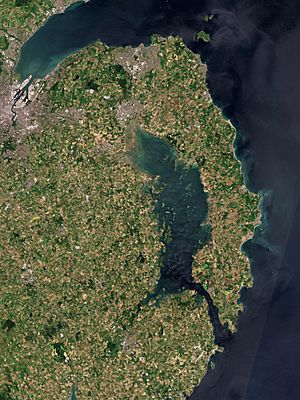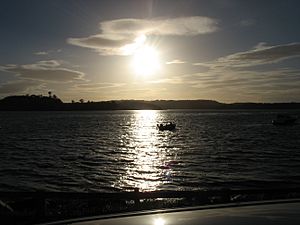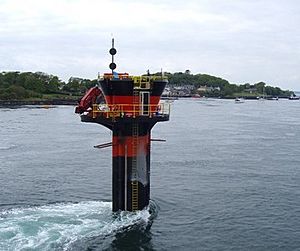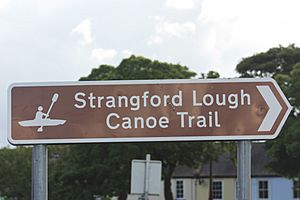Strangford Lough facts for kids
Strangford Lough (from Old Norse Strangr Fjörðr, meaning "strong sea-inlet") is a large sea loch or inlet in County Down, in the east of Northern Ireland. It is the largest inlet in the British Isles, covering 150 km2 (58 sq mi). The lough is almost totally enclosed by the Ards Peninsula and is linked to the Irish Sea by a long narrow channel at its southeastern edge. The main body of the lough has at least seventy islands along with many islets (pladdies), bays, coves, headlands and mudflats. Strangford Lough was designated as Northern Ireland's first Marine Conservation Zone (MCZ) under the introduction of the Marine Act (Northern Ireland) 2013. It has also been designated a Special Area of Conservation under the EU Habitats Directive, and its abundant wildlife is recognised internationally for its importance.
In the medieval and early modern period Strangford Lough was known in Irish as Loch Cuan, meaning "sea-inlet of bays/havens".
Strangford Lough is a popular tourist destination noted for its fishing and scenery. Towns and villages around the lough include Killyleagh, Comber, Newtownards, Portaferry and Strangford. The latter two straddle either shore of the narrow channel connecting the lough to the Irish Sea, and are connected by a car ferry.
Contents
Name
The name Strangford comes from Old Norse Strangr-fjörðr, meaning 'strong sea-inlet'. The Vikings were active in the area during the Middle Ages. Originally, this name referred only to the narrow channel linking the lough to the sea (between the villages of Strangford and Portaferry). Up until about the 18th century, the main body of the lough was better known by the (older) Irish name Loch Cuan, meaning "loch of the bays/havens". This name was anglicized as Lough Coan, Lough Cone, Lough Coyn, Lough Coin, or similar.
The narrow channel may have been known in Latin as the fretum Brene. In Ulster-Scots the lough's name is spelt Strangfurd or Strangfirt Loch.
Ptolemy's Geography (2nd century AD) described a point called Ουινδεριος (Winderios, "pleasant river") which may have referred to Strangford Lough.
Geology
The loch was formed at the end of the last ice age and is generally under 10m deep, but can reach 50-60m in parts, generally the centre channel.
Flora
Flowering plants
Common cord-grass (Spartina anglica) C.E. Hubbard was introduced in the mid-1940s is now abundant.
Algae
Maerl is a calcareous deposit, in the main, of two species, of calcareous algae Phymatolithon calcareum and Lithothamnion glaciale which form free-living beds of unattached, branched corallines, living or dead, in Strangford Lough.
The rocky and boulder shores toward the south of the lough are dominated by the seaweed knotted wrack Ascophyllum nodosum. The usual zonation of weeds on these shore is, at the top channel wrack (Pelvetia canaliculata (L.) Dcne. et Rhur.), followed by spiral wrack (Fucus spiralis L.), then knotted wrack (Ascophyllum nodosum (L.) Le Jol) with some admixture of bladder wrack (Fucus vesiculosus) L. and then serrated wrack (Fucus serratus L.) before coming to the low water kelps.
A brown seaweed named Sargassum muticum, originally from the Pacific (Japan) was discovered on 15 March 1995 in Strangford Lough at Paddy's Point. The plants were well established on mesh bags containing oysters. The bags had been put out in 1987 containing Pacific oysters (Crassostrea gigas) imported from Guernsey. This Sargassum is known to be a highly invasive species.
Other algae include:
- Apoglossum rusciofolium (Turn.) J. Ag.
- Spyridia filamentosa (Wulf.) Harv.
- Sphondylothamnion multifium (Huds.) Näg.
- Griffithsia corallinoides (L.) Batt.
- Compsothamnion gracillimum de Toni
- Compsothamnion thuyoides (Sm.) Schmitz
- Calliothamnion corymbosum (Sm.) Lyngb
- Rhodymenia delicatula P.Dang.
- Haemescharia hennedyi (Harv.) Vinogradova
- Rhodophyllis divaricate (Stackh.) Papenf.
- Calliblepharis jubata (Good. et Woodw.) Kütz.
- Calliblepharis ciliata (Huds.) Kütz
- Peyssonnelia dubyi P. et H. Crouan
- Plagiospora gracilis Kuck
- Gloiosiphonia capillaris (Huds.) Carm.
- Dudresnaya verticillata (With.) Le Jol.
- Scinaia pseudocrispa (Clem.)
- Cremades/S. turgida Chemin
- Porphyropsis coccinea (J.Ag. ex Aresch) Rosenv.
- Pelvetia canaliculata (L.) Dcne. et Thur.
- Fucus vesiculosus var. volubilis Turn.
- Fucus cottonii Wynne et Magne
- Colpomenia peregrine (Sauv.) Hame
- Asperococcus compressus Griff. ex Hook.
- Striaria attenuate (Grev.) Grev.
- Myriotrichia clavaeformis Harv.
- Tilopteris mertensii (Turn.) Kütz.
- Chordaria flagelliformis (O.F.Müll.) C.Ag.
- Spermatochnus paradoxus (Roth) Kütz.
- Pseudolithoderma extensum (P. et H. Crouan) Lund.
- Enteromorpha ralfsii Harv.
- Chlorochytrium sp.
Fauna
Strangford Lough and Islands is an Important Bird Area. Strangford Lough is an important winter migration destination for many wading and sea birds. Animals commonly found in the lough include common seals, basking sharks and brent geese. Three quarters of the world population of pale bellied brent geese spend winter in the lough area. Often the numbers are up to 15,000.
The invasive carpet sea squirt, Didemnum vexillum, was found in the Lough in 2012.
Tidal electricity
In 2007 Strangford Lough became home to the world's first commercial tidal stream power station, SeaGen. The 1.2 megawatt underwater tidal electricity generator, part of Northern Ireland's Environment and Renewable Energy Fund scheme, took advantage of the fast tidal flow in the lough which can be up to 4 m/s. Although the generator was powerful enough to power up to a thousand homes, the turbine had a minimal environmental impact, as it was almost entirely submerged, and the rotors turned slowly enough that they pose no danger to wildlife.
In 2008 a tidal energy device called Evopod was tested in Strangford Lough near the Portaferry Ferry landing. The device was a 1/10 scale prototype, monitored by Queen's University Belfast. The device was a semi-submerged floating tidal turbine, moored to the seabed via a buoy-mounted swivel. The scale device was not grid connected.
Sports
In July 2016 the Strangford Lough and Lecale Partnership, Scottish Coastal Rowing Association, Newry, Mourne and Down District Council and Ards and North Down Borough Council, together with local rowing clubs based on Strangford Lough and the Ards Peninsula hosted the world community, coastal rowing championships “Skiffie Worlds 2016”. The event was attended by 50 clubs from Scotland, England, Northern Ireland, the Netherlands, The United States, Canada and Tasmania. Racing was held over a 2 km course on Strangford Lough at Delamont Country Park.
Ferry
The Portaferry–Strangford ferry service has linked Portaferry and Strangford, at the mouth of the Lough, without a break and for almost four centuries. The alternative road journey is 47 miles (76 km) and takes about an hour and a half, while the ferry crosses the 0.6-nautical-mile (0.69 mi; 1.1 km) strait in 8 minutes. The subsidised public service carries both passengers and vehicles, and operates at a loss of more than £1m per year but is viewed as an important transport link to the Ards Peninsula.
Archaeology
Strangford Lough has a substantial archaeological heritage. Intertidal archaeological surveys in recent years have brought hundreds of sites to light, including fish traps, tidal mills, kelp walls and harbours and landing places.
See also
 In Spanish: Strangford Lough para niños
In Spanish: Strangford Lough para niños








